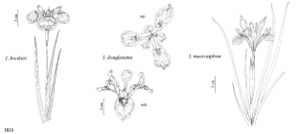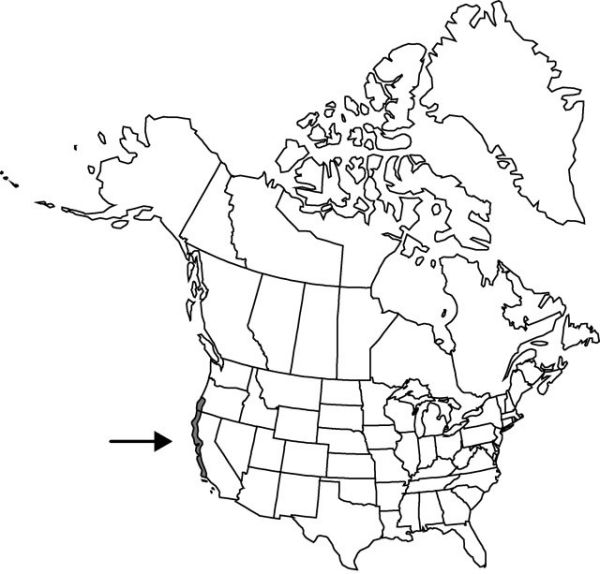Difference between revisions of "Iris douglasiana"
in W. J. Hooker and G. A. W. Arnott, Bot. Beechey Voy., 395. 1840.
FNA>Volume Importer |
FNA>Volume Importer |
||
| Line 12: | Line 12: | ||
|name=Iris beecheyana | |name=Iris beecheyana | ||
|authority=Herbert | |authority=Herbert | ||
| − | }}{{Treatment/ID/Synonym | + | }} {{Treatment/ID/Synonym |
|name=Iris douglasiana var. alpha | |name=Iris douglasiana var. alpha | ||
|authority=Dykes | |authority=Dykes | ||
| − | }}{{Treatment/ID/Synonym | + | }} {{Treatment/ID/Synonym |
|name=Iris douglasiana var. altissima | |name=Iris douglasiana var. altissima | ||
|authority=Purdy ex Jepson | |authority=Purdy ex Jepson | ||
| − | }}{{Treatment/ID/Synonym | + | }} {{Treatment/ID/Synonym |
|name=Iris douglasiana var. beecheyana | |name=Iris douglasiana var. beecheyana | ||
|authority=(Herbert) Baker | |authority=(Herbert) Baker | ||
| − | }}{{Treatment/ID/Synonym | + | }} {{Treatment/ID/Synonym |
|name=Iris douglasiana var. bracteata | |name=Iris douglasiana var. bracteata | ||
|authority=Herbert | |authority=Herbert | ||
| − | }}{{Treatment/ID/Synonym | + | }} {{Treatment/ID/Synonym |
|name=Iris douglasiana var. major | |name=Iris douglasiana var. major | ||
|authority=Torrey | |authority=Torrey | ||
| − | }}{{Treatment/ID/Synonym | + | }} {{Treatment/ID/Synonym |
|name=Iris douglasiana var. mendocinensis | |name=Iris douglasiana var. mendocinensis | ||
|authority=Eastwood | |authority=Eastwood | ||
| − | }}{{Treatment/ID/Synonym | + | }} {{Treatment/ID/Synonym |
|name=Iris douglasiana var. nuda | |name=Iris douglasiana var. nuda | ||
|authority=Herbert | |authority=Herbert | ||
| − | }}{{Treatment/ID/Synonym | + | }} {{Treatment/ID/Synonym |
|name=Iris douglasiana var. oregonensis | |name=Iris douglasiana var. oregonensis | ||
|authority=R. C. Foster | |authority=R. C. Foster | ||
| − | }}{{Treatment/ID/Synonym | + | }} {{Treatment/ID/Synonym |
|name=Iris watsoniana | |name=Iris watsoniana | ||
|authority=unknown | |authority=unknown | ||
| Line 53: | Line 53: | ||
|habitat=Open woods, sunny slopes and fields | |habitat=Open woods, sunny slopes and fields | ||
|distribution=Calif.;Oreg. | |distribution=Calif.;Oreg. | ||
| − | |discussion=<p>R. C. Foster (1937) named several varieties of Iris douglasiana, about which L. W. Lenz (1954) said, “This is a widespread and extremely variable species whose total variability is being increased due to introgressive hybridization between it and other species with which it has come into contact. Well marked and distinct geographic races cannot be detected; however, pronounced variations are to be found within a single population. For these reasons no attempt is made here to segregate taxa within such a polymorphic species.”</p><!-- | + | |discussion=<p>R. C. Foster (1937) named several varieties of <i>Iris douglasiana</i>, about which L. W. Lenz (1954) said, “This is a widespread and extremely variable species whose total variability is being increased due to introgressive hybridization between it and other species with which it has come into contact. Well marked and distinct geographic races cannot be detected; however, pronounced variations are to be found within a single population. For these reasons no attempt is made here to segregate taxa within such a polymorphic species.”</p><!-- |
| − | --><p>Iris douglasiana hybridizes with I. bracteata, I. chrysophylla, I. fernaldii, I. hartwegii, I. innominata, I. macrosiphon, I. munzii, I. purdyi, I. tenax, and I. tenuissima. The natural hybrid between I. douglasiana and I. innominata has been designated as Iris ×thompsonii R. C. Foster and the garden hybrid as Iris ×aureonympha E. H. English.</p> | + | --><p><i>Iris douglasiana</i> hybridizes with <i>I. bracteata</i>, <i>I. chrysophylla</i>, <i>I. fernaldii</i>, <i>I. hartwegii</i>, <i>I. innominata</i>, <i>I. macrosiphon</i>, <i>I. munzii</i>, <i>I. purdyi</i>, <i>I. tenax</i>, and <i>I. tenuissima</i>. The natural hybrid between <i>I. douglasiana</i> and <i>I. innominata</i> has been designated as <i>Iris</i> ×thompsonii R. C. Foster and the garden hybrid as <i>Iris</i> ×aureonympha E. H. English.</p> |
|tables= | |tables= | ||
|references= | |references= | ||
| Line 77: | Line 77: | ||
|publication year=1840 | |publication year=1840 | ||
|special status= | |special status= | ||
| − | |source xml=https://jpend@bitbucket.org/aafc-mbb/fna-data-curation.git/src/ | + | |source xml=https://jpend@bitbucket.org/aafc-mbb/fna-data-curation.git/src/8f726806613d60c220dc4493de13607dd3150896/coarse_grained_fna_xml/V26/V26_784.xml |
|genus=Iris | |genus=Iris | ||
|subgenus=Iris subg. Limniris | |subgenus=Iris subg. Limniris | ||
Revision as of 16:47, 18 September 2019
Rhizomes freely branching, forming large colonies, slender, 0.8–0.9 cm diam., covered with remains of old leaves; roots fibrous. Stems 1–4-branched, solid, 1.5–7 dm. Leaves: basal with blade yellow-green, occasionally darker green, sometimes flushed pink or red basally, prominently ribbed, linear, 4.5–10 dm × 2 cm, apex acute; cauline 1–3, reduced. Inflorescence units (2–)3-flowered, branch units 2–3-flowered; spathes opposite or separated, divergent, green, sometimes flushed purple basally, lanceolate-acuminate, 6–12 cm × 7–12 mm. Flowers: perianth deep red-purple, lavender, gray-blue, cream, or white, with gold signal and blue or purple veins; floral tube 1.5–2.8 cm, usually widening to bowl shape at base of flower; sepals oblanceolate to obovate, 5–9 × 1.4–3 cm, base gradually attenuate, apex obtusely rounded; petals oblanceolate, 4.5–7 × 0.9–1.8 cm, base attenuate to narrow claw; ovary elliptic-oval, sharply triangular in cross section, 3–4 cm; style 1.7–3.5 cm; crests overlapping, subquadrate, 1–2 cm, margins coarsely toothed; stigmas triangular; pedicel 2–5 cm. Capsules sharply triangular in cross section with ridge at each angle, tapering at both ends, remnant of floral tube forming tip at apex, 2.5–5 cm. Seeds dark brown, pyriform, wrinkled. 2n = 40.
Phenology: Flowering Apr–Jun.
Habitat: Open woods, sunny slopes and fields
Discussion
R. C. Foster (1937) named several varieties of Iris douglasiana, about which L. W. Lenz (1954) said, “This is a widespread and extremely variable species whose total variability is being increased due to introgressive hybridization between it and other species with which it has come into contact. Well marked and distinct geographic races cannot be detected; however, pronounced variations are to be found within a single population. For these reasons no attempt is made here to segregate taxa within such a polymorphic species.”
Iris douglasiana hybridizes with I. bracteata, I. chrysophylla, I. fernaldii, I. hartwegii, I. innominata, I. macrosiphon, I. munzii, I. purdyi, I. tenax, and I. tenuissima. The natural hybrid between I. douglasiana and I. innominata has been designated as Iris ×thompsonii R. C. Foster and the garden hybrid as Iris ×aureonympha E. H. English.
Selected References
None.

